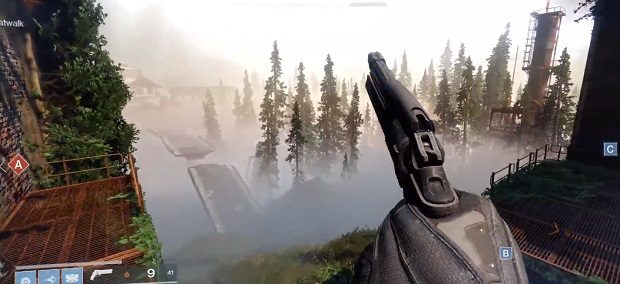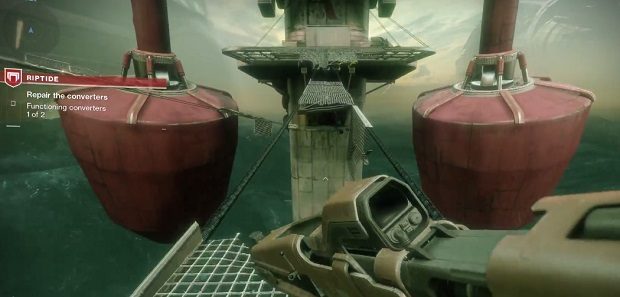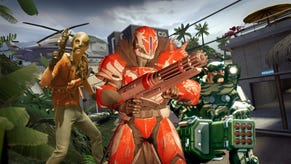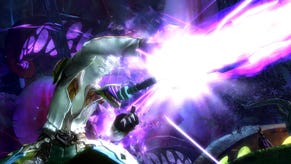Wot I Think: Destiny 2
Embrace it?
It’s 4AM and I’m whispering with strangers in the dark. I found them online through a private channel, arranged a meeting in secret, and set my alarm to wake under cover of night. We’ve already got a plan, but we need to talk it through, to get on board with each other. We need to make sure we won’t get caught this time.
I promised my wife I’d stop doing this, but these are the sacrifices I have to make in order to finish Destiny 2’s Leviathan raid.
Leviathan is the crown jewel of Bungie’s MMO-ish shooter: a turbo-complex multi-stage mission that requires six people to complete. Those six people can’t just show up, either. They need to be willing to commit consecutive hours of their lives to communicating, implementing, and then executing multiple multi-stage plans. They’re expected to know each of those plans ahead of time, and to be able to rattle them off in chat channels with military precision. They’re expected to bring their best gear — armour and guns — and then they’re expected to never miss a headshot.
For this endeavour, Destiny 2 offers two rewards: one intangible and one tangible. The former is an intoxicating sense of satisfaction at beating such a sustained mechanical challenge with a fire-forged group of new friends. The latter is some new guns and armour of slightly higher quality with which they can do it all again.
They show Destiny 2 game at both its best — as a frequently beautiful and consistently enjoyable shooter — and its worst, as a grinding loot box that ends up paying out in frustratingly small increments.
The shooting comes first, and Destiny 2’s guns feel uniformly fantastic. There’s a huge number of them, and while they fall into specific archetypes, there’s variation within those templates. Scout rifles — scoped and single-shot weapons by definition — are my favourite for story missions and aimless patrols, but I prefer to break out my Vigilance Wing pulse rifle for Destiny 2’s PvP activities.
Vigilance Wing is a grand and gold-plated thing, bedecked in Egyptian symbols and finished off with two sweeping wings on its sides. Where most pulse rifles fire three-bullet bursts, this kid shoots five, making kills in Destiny 2’s multiplayer Crucible a doddle — assuming I can aim my first two bursts above the neck.
I have the same affection for the MIDA Multi-Tool, an understated and functional-looking scout rifle that shoots with a pleasant clicking sound. Same goes for the Wardcliff Coil, which looks like the head of a jury-rigged microphone and shoots a hailstorm of weird blue bolts in the vicinity of its target. Or Merciless: a boss-melting fusion rifle that gets angrier if it doesn’t kill its target, charging faster with every repeat shot.
These guns are just some of Destiny 2’s Exotics: specialised and memorable weapons earned either through convoluted quest chains, or randomly awarded as drops. But even its standard guns feel like they’ve had similar amounts of care lavished on their kick, their bark, their reload animations, and their whole feel.
They have lost something from their console transition — specifically, an over-eager auto-aim that made controller shooting surprisingly easy. On PC, with the precision of mouse and keyboard, auto-aim is disabled, meaning your reticule placement is entirely on you. This is a sensible shift, and one that needed to be made in order to keep Destiny 2’s competitive multiplayer modes feeling fair.
Auto-aim’s not gone entirely: Bungie says that it’s kept it in the game for controller users, a decision that’s already controversial. It would be tough to give up mouse control, though, which feels smooth and precise — there’s none of the unpredictable acceleration that some console transitions end up lumbered with. By tying shooting to mouse clicks rather than chunkier trigger pulls, Destiny 2’s PC shooting feels a touch flimsier than its console cousin, but not by much: bullets have a distinct visual heft, connecting with enemy torsos, arms, and legs with obvious thunks.
Those enemies come from various species, and include the scuttling Fallen, the chitinous Hive, and the weird, shimmering Taken. You’ll also face the Cabal — genocidal space turtles who want to capture the weird power that makes Destiny 2’s player characters immortal. These waddling monsters are fat, grumpy, and my favourite things to shoot, especially when you hit them in the head — at which point their helmets fly off with a ping, a cloud of previously pressurised gas, and an accompanying curse in an angry alien language.
On console and controller, a lot of the heavy lifting in making the weapons feel good is done via rumble and force feedback. On PC and mouse, however, it’s clear that so much of Destiny 2’s great gunfeel actually comes from that sound design: a suite of booms, bangs, and bursts that keeps shooting fun. It’s hugely important that shooting remains fun, too: the MMO-ish structure of the game means you’ll be pootling around its public areas and be replaying its strikes, raids, and patrol missions and again and again.
There are a set of core story missions, too, that cast the player as a Guardian from Earth, stripped of their Light (the power that makes them able to resurrect on death) by king of the angry space turtles, Dominus Ghaul. In order to reclaim that Light, you’ll hop from Earth to the moons of Io and Titan, as well as the imaginary minor planet Nessus, brought back to our solar system by robotic hive mind species the Vex.
Even for the creators of the Halo series, Destiny lore is dense, but Destiny 2 is wildly more comprehensible than its predecessor. Destiny 1 never came to PC, but genuinely included the line “I don’t have time to explain why I don’t have time to explain.” (For extra points, that line was provided by a character whose mission, allegiance, and even name is still unknown.) For ease of understanding, Destiny 2 leans far harder on a few core characters, established already in the pre-existing fiction and given clear personalities by the very earliest cut-scenes. There’s the mystical Ikora Rey, the stoic Commander Zavala, and the cheeky Cayde-6, each voiced by mid-tier celebrities (Gina Torres, Lance Reddick, and Nathan Fillion respectively).
They popped up in a six-hour campaign that reached an impressive crescendo after first laying my character low, and then letting me bring her back to power. Missions aren’t structured in particularly thrilling ways — it’s a shooting gallery all the way to infrequent bosses — but they’re set against some of gaming’s juiciest vistas. It’s a beautiful game, especially on a powerful PC, where its huge stages run smoothly. Titan, in particular, is incredible, with a greeny blue terraformed ocean that bats cargo ships around like toys and makes me feel like a tiny speck of insignificance in an uncaring solar system.
That’s the same even on underpowered PCs, where “low” quality settings still produce pretty views at high frames-per-second. Destiny 2’s also picked up a grab bag of graphical options — including Vsync and an FOV slider that goes all the way to 105 — that the console kids didn’t get. It all contributes to some spectacular moments, especially when, mid-mission, Destiny 2 decides to ramp up the spectacle.
Its missions are coherent, well-paced, and given the views, clearly expensive. But that makes it all the weirder that Destiny 2 is happy to jettison its story missions as soon as you’ve played them once. Repetition is the name of the game with three-player strike missions, patrol quests, and the Leviathan raid, which asks players to come back every week to get the best endgame gear. In order to do the story missions again, however, you’ll need to visit Ikora Rey to pick up one of a limited pool of “memories,” or start a new character entirely.
I think it’s so willing to drop these story missions because although it dresses up in the clothes of a first-person shooter, Destiny 2 is something else. I’ve been calling it “MMO-ish” so far, but that’s inaccurate. It’s first-person, and there is shooting, sure, but it’s not “MMO-ish” — it’s just an MMO. It’s got daily challenges, it’s got social spaces shared between players, and it’s even got little numbers that pop out of enemies when you damage them. Most importantly, it has buckets of loot, and it has a levelling system designed to keep players grinding away for incremental increases to their strength.
Actually, it has two levelling systems. Destiny 2’s character level system is simple: a straight shot from level one to level 20 that most players will max out by playing through the story missions on offer. Its other system is far more involved, is tied to players’ gear, and is the reason I set my alarm for 4AM to finish the Leviathan raid with internet randos.
A player’s weapons, armour, and accoutrements are all assigned their own level, from 10 to 305 (at present). These numbers are then averaged out and assigned to the player as their own “light level.” That light level defines a player’s ability to take on late-game tasks like the Leviathan raid, which in turn pay out with even higher-tier loot to push that level further.
The system means that a player with a full suite of 305 armour and guns will hit the level cap, but — for the first few months at least — you’ll likely be sitting somewhere between 280 and 300. I’m stuck in this limbo right now, my level dragged up by a fancy pulse rifle I got when my clanmates finished a weekly event, but pulled back down by a terribly uncool helmet.
It’s far less binary than a more standard character experience system, stratifying Destiny 2’s endgame as a very slow getting-ready-for-a-night-out montage: I need the perfect hat, the perfect trousers, the perfect cape. An infusion system also means you can continue to imbue your favourite pair of space leggings with your more powerful gear, or, as in my case, continue to wear the chest armour with the fluffiest collar all the way into the next year.
But the system can also be grindingly annoying when it doesn’t spit out the things you need. Especially when you dedicate five hours at 4AM to complete the punishing Leviathan raid and your reward is the same pair of gloves you got last time — albeit at a slightly lower level.
Other missions, including the three-player strikes and the daily challenges, don’t give out loot directly. Instead they use a token system, handing the player chits that can be traded in with fully voiced vendors in the game’s social spaces and on each of its planets. Hand over enough of these tokens and you’re guaranteed regular loot (generally at a lower level than your current), but despite working to democratise the obtaining of new weapons and armour, the system is weirdly dissatisfying.
It’s disappointing, because Destiny 2’s token system sounds like it should be an upgrade over Destiny 1’s more random loot drops. It ensures that players aren’t grinding for days only to get nothing, keeps a constant stream of new items coming in, and makes an easy way to measure progress from game start to endgame. Still though, I don’t like it. Few games have laid my basic meatbrain stupidity out as clearly as Destiny 2, but I can’t help it: I just don’t get the same dopamine spikes when I pull something new out of the big invisible loot pile as I do in other games.
That’s also because it’s so much easier to just get all of the stuff I want in Destiny 2 than it was in Destiny 1. That problem isn’t helped by the game’s weapon perk system, which locks specific bonuses to specific types of gun. A “Does Not Compute” scout rifle, for example, will always come with the same three sights, the same boosts to movement speed while aiming, and the same choice between bonuses to aim stability or a magazine increase. This reduces the excitement of pulling new loot, as once you’ve got one Does Not Compute, getting a second becomes pointless.
Half the guns you most likely won’t even want. Despite Destiny 2’s huge arsenal, a handful of guns have risen to the top as the only acceptable weapons to use in both PvE and PvP environments. The previous game’s system — in which perks were randomly generated and players were praying for a gun’s “god roll” — could involve far more grind, but also allowed for far greater difference between play styles.
Similar edges were sanded off Destiny 1’s PvP Crucible mode, to its arguable detriment. Where the previous game had a six-on-six format, Destiny 2 casts teams of four against each other, and rotates game modes at random. The result is a slower game that — on console at least — has calcified already, all but demanding that players roam the map in tight groups, picking off opponents that have wandered from the herd with one of four or five communally sanctioned weapons.
On PC there’s a chance that metagame could wander into more interesting territory, but in these early days, I’m more inclined to believe it’ll continue in the same vein. Laser accurate scout rifles are currently the top of the pile of guns, and the increased aiming ability offered by the mouse is likely to keep them there. More of a shift could be caused by Bungie themselves, who have been willing in the past to step in and make tweaks to both individual guns and weapon categories wholesale, but they’ve not always been quick to do so.
I know Bungie can be slow to make these changes because Destiny 1 took over my life for a time. I spent that year playing and replaying the same missions, hoping for the perfect weapon drop, and hanging on the company’s every tweet for months at a time. In its current state, I’ll be done with Destiny 2 much sooner, having already picked up the majority of its goodies and blasted through most of its endgame.
Until then, though, I’ve got an alarm set for 4AM next Wednesday morning. And the Wednesday morning after that, and probably the Wednesday morning after that. And if a slick, beautiful shooter is keeping you up at night for a month, isn’t that sometimes enough?
Note: This Destiny 2 review has been written after spending several hours on the PC version of the game, and more than 50 hours with its console counterpart. While graphical settings, menus, and control schemes are different from PC to console — and have been explored specifically in this writeup — the story, missions, and activities on offer remain the same.
Once we’ve had more time to try the game on varying machines of varying quality, we’ll also follow-up with another piece that speaks to the PC-specific tech experience. Destiny 2 will also change in the future as Bungie makes tweaks and releases new DLC. Expect RPS to update our collective opinions accordingly at that time.
Destiny 2 is out now for Windows and is available via battle.net and other retailers for £44.99.
























